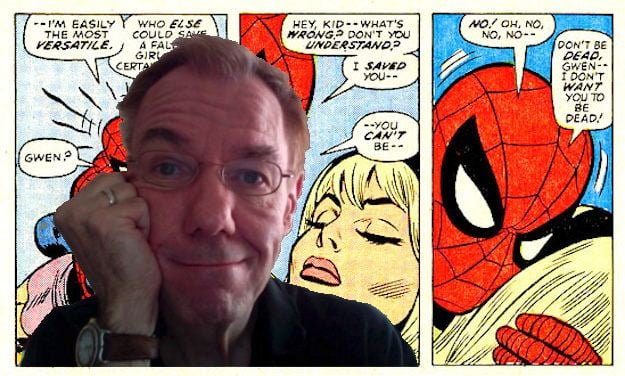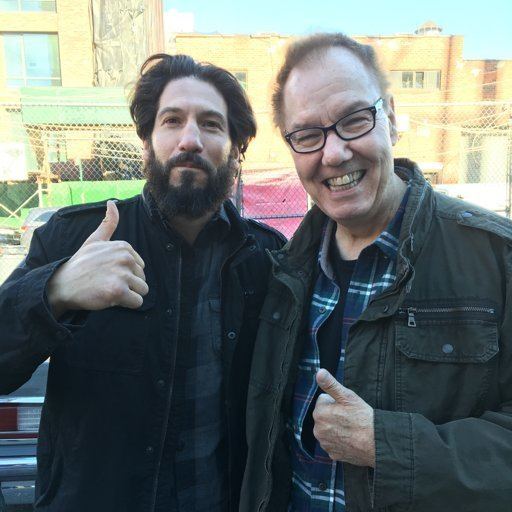Nationality American Spouse Karen Britten (m. 1992) Role Writer | Name Gerry Conway Area(s) Writer, Editor | |
 | ||
Movies Fire and Ice, Conan the Destroyer, A Twist of the Knife Children Rachel Conway, Cara Conway Books The Amazing Spider‑M, Crisis on Multiple Earths - V, The Amazing Spider‑M, Kamandi: The Last Boy On E, Spider‑Man: The Cosmic A Similar People Ross Andru, Roy Thomas, John Romita Sr, Len Wein, Sal Buscema | ||
Gerry conway talks about being editor in chief at marvel comics
Gerard F. Conway (; born September 10, 1952) is an American writer of comic books and television shows. He is known for co-creating the Marvel Comics' vigilante the Punisher and scripting the death of the character Gwen Stacy during his long run on The Amazing Spider-Man. At DC Comics, he is known for co-creating the superhero Firestorm and others, and for writing the Justice League of America for eight years. Conway wrote the first major, modern-day intercompany crossover, Superman vs. the Amazing Spider-Man.
Contents
- Gerry conway talks about being editor in chief at marvel comics
- Superior spider talk 31 amazing friends w gerry conway podcast
- Early career
- Spider Man and intercompany rotation
- DC Comics and later career
- Books comic strips screenplays
- Personal life
- Audiovideo
- Television credits
- References

Superior spider talk 31 amazing friends w gerry conway podcast
Early career

Born in Brooklyn, New York City, Conway grew up a comic fan; a letter from him appears in Fantastic Four #50 (May 1966), written when Conway was 14. He published his first professional comic book work at 16, with the 6½-page horror story "Aaron Philips' Photo Finish" in DC Comics' House of Secrets #81 (Sept. 1969). He continued selling such anthological stories for that series and for Marvel's Chamber of Darkness and Tower of Shadows through the end of 1970, by which time he had also published one-page, text short stories in DC's All-Star Western #1 (Sept. 1970) and Super DC Giant #S-14 (Oct. 1970). He published his first continuing-character story in DC's semi-anthological occult comic The Phantom Stranger #10 (Dec. 1970). He attended New York University for a time.

Conway recalled breaking into Marvel Comics through Marvel editor Roy Thomas:

I'd been writing for DC Comics for two or three years . . . but to paraphrase the joke about the actor's ambitions to be a director, what I really wanted to do was write superheroes – specifically Marvel heroes. Through friends I'd become acquainted with Roy Thomas, who was Stan Lee's right-hand man at the time, and Roy offered me a shot at the Marvel 'writing test.' Stan wasn't impressed, but Roy liked what I did, and began throwing some short assignments my way, including scripting over his plot on an early Ka-Zar [story]. . . .

Following his first continuing-character story for Marvel, with his script for the jungle lord Ka-Zar in Astonishing Tales #3 (Dec. 1970), Conway began writing superhero stories with Daredevil #72 (Jan. 1971). He quickly went on to assignments on Iron Man, The Incredible Hulk, and both "The Inhumans" and "The Black Widow" features in the split book Amazing Adventures. He scripted the first Man-Thing story, in 1971, sharing co-creation credit with Stan Lee and Roy Thomas. Conway would eventually script virtually every major Marvel title, as well as co-create (with writers Roy & Jean Thomas and artist Mike Ploog) the lycanthropic lead character of the feature "Werewolf by Night", in Marvel Spotlight #2 (Feb. 1972); and write the premiere issue of Marvel's The Tomb of Dracula, introducing the longstanding literary vampire into the Marvel universe.
Spider-Man and intercompany rotation
At 19, Conway began scripting The Amazing Spider-Man, succeeding Stan Lee as writer of one of Marvel's flagship titles. His run, from issues #111–149 (August 1972 – October 1975), included the landmark death of Gwen Stacy story in #121 (June 1973). Eight issues later, Conway and Andru introduced the Punisher as a conflicted antagonist for Spider-Man, as well as the Jackal. The Punisher went on to become a popular star of numerous comic books and has been adapted into three movies. Conway additionally wrote Fantastic Four, from #133–152 (April 1973 – Nov. 1974).
Conway in 2009 reflected on writing flagship Marvel characters at a very young age:
Precocity is a well-known curse; most of the pressure I felt as a younger writer was self-imposed. I wanted to be accepted by other writers and artists as an equal, which put me in some awkward situations – pretending to be more mature than I was, emotionally and professionally. As it happened, I was pretty good at faking a maturity I didn't have, which had advantages and, obviously, some disadvantages. I think people often forgot how young I was, and expected me to perform at a level that was actually beyond me. The result was, I was pretty stressed for most of my early career as a writer, and I often felt like I had no idea what I was doing —which was true. I wrote instinctively and from the gut; when those instincts were appropriate to the material I was writing – for example, when I was writing [The Amazing] Spider-Man — the results were something I was quite proud of, then and now. When my instincts were off, I didn't have the experience to either recognize it, or to compensate for it, with results that were more uneven.
In the fall of 1972, Conway and writers Steve Englehart and Len Wein crafted a metafictional unofficial crossover spanning titles from both major comics companies. Each comic featured Englehart, Conway, and Wein, as well as Wein's first wife Glynis, interacting with Marvel or DC characters at the Rutland Halloween Parade in Rutland, Vermont. Beginning in Amazing Adventures #16 (by Englehart with art by Bob Brown and Frank McLaughlin), the story continued in Justice League of America #103 (by Wein, Dick Dillin and Dick Giordano), and concluded in Thor #207 (by Conway and penciler John Buscema). As Englehart explained in 2010, "It certainly seemed like a radical concept and we knew that we had to be subtle (laughs) and each story had to stand on its own, but we really worked it out. It's really worthwhile to read those stories back to back to back – it didn't matter to us that one was at DC and two were at Marvel – I think it was us being creative, thinking what would be really cool to do."
Conway returned to DC Comics in mid-1975, beginning with three books cover-dated Nov. 1975: Hercules Unbound #1, Kong the Untamed #3, and Swamp Thing #19. He wrote a revival of the Golden Age comic book series All Star Comics which introduced the character Power Girl. Shortly afterward, he was chosen by Marvel and DC editors to script the historic intercompany crossover Superman vs. the Amazing Spider-Man #1, a 96-page, tabloid-sized, $2 one-shot, at a time when comic books sold for 25 cents.
He continued writing for DC, on titles including Superman, Detective Comics (starring Batman), Metal Men, Justice League of America, 1st Issue Special #11 starring Codename: Assassin, and that of the licensed character Tarzan. Conway briefly returned to Marvel where he succeeded Marv Wolfman as editor-in-chief in March 1976, but held the job only "about a month-and-a-half," relinquishing the post and being succeeded by Archie Goodwin.
For a time, a confluence of publishing schedules resulted in Conway stories appearing in both Marvel and DC comics in the same month: The prolific Conway's comic books with January 1977 cover-dates alone, for example, are Marvel's The Avengers, The Defenders, Captain Marvel, Iron Man, The Spectacular Spider-Man, and the premiere issues of Ms. Marvel and Logan's Run, and Superman and Action Comics.
DC Comics and later career
After leaving Marvel's editorship, he again wrote exclusively for DC for the next decade writing both major and lesser titles – from those featuring Superman, Wonder Woman, and the Legion of Super-Heroes to such books as Weird Western Tales, Atari Force and Sun Devils. He had an eight-year run on Justice League of America, writing most issues from #151–255 (Feb. 1978 – Oct. 1986) including the double-sized anniversary issue #200 (March 1982). Conway wrote two additional Superman projects in the oversized tabloid format, Superman vs. Wonder Woman, drawn by José Luis García-López, and Superman vs. Shazam, drawn by Rich Buckler.
He co-created the characters Firestorm with artist Al Milgrom and Steel, the Indestructible Man with artist Don Heck in the premiere issues (both March 1978) of the respective titular comics. Two other Conway co-creations, the Deserter (with artist Dick Ayers) and the Vixen (with artist Bob Oksner) were scheduled to receive their own series as well but were canceled before any issues were published. He additionally co-created the characters Vibe and Gypsy. As writer of Batman #337–359 (July 1981 – May 1983) and the feature "Batman" in Detective Comics #497–526 (Dec. 1980 – May 1983), he introduced the characters Killer Croc and Jason Todd, the latter of whom became the second Robin, succeeding original sidekick Dick Grayson. With artist Gene Colan, Conway revived the Golden Age supervillains Doctor Death in Batman #345 (March 1982) and the Monk in Batman #350 (Aug. 1982).
Conway was a frequent collaborator with Roy Thomas. Together they wrote a two-part Superman – Captain Marvel team-up in DC Comics Presents #33–34 (May–June 1981); the Atari Force and Swordquest mini-comics packaged with Atari 2600 video games; and three Justice League of America-Justice Society of America crossovers. Conway contributed ideas to the funny animal comic Captain Carrot and His Amazing Zoo Crew!, created by Thomas and Scott Shaw. Thomas and Conway were to be the co-writers of the JLA/Avengers intercompany crossover, but editorial disputes between DC and Marvel caused the project's cancellation. Conway was one of the contributors to the DC Challenge limited series in 1986.
He returned to Marvel in the 1980s and served as the regular writer of both The Spectacular Spider-Man and Web of Spider-Man from 1988 until 1990. Conway stated in 1991 that "I understand the character a lot better now than I did when I was nineteen. And one of the nice things about the Marvel characters is that you can keep them fresh by changing them just a bit." His run on Spectacular included such story arcs as the "Lobo Brothers Gang War". He relinquished writing duties on both titles when he became the story editor of the television series Father Dowling Mysteries.
Conway's last recorded comics credit for many years was Topps Comics' "Kirbyverse" one-shot NightGlider #1 (April 1993), scripting from a Roy Thomas plot. Conway returned to comics in 2009 and wrote DC Comics' The Last Days of Animal Man, with artist Chris Batista. In 2011, he wrote the DC Retroactive: Justice League – The '80s one-shot. In 2015, he returned to Spider-Man by writing a story in Spider-Verse Team Up #2. featuring alternate versions of Spider-Man and Gwen Stacy, and the "Spiral" storyline in Amazing Spider-Man #16.1–20.1.
Books, comic strips, screenplays
In addition to comics, Conway published two science-fiction novels: The Midnight Dancers and Mindship He also wrote the February 14 – December 3, 1983 dailies of the syndicated newspaper comic strip Star Trek, based upon the 1960s TV series.
Conway as well moved into screenwriting in the 1980s, starting with the animated feature Fire and Ice (1983), co-written with Roy Thomas, based on characters created by Ralph Bakshi and Frank Frazetta. Conway and Thomas wrote the story basis for Stanley Mann's screenplay for the film Conan the Destroyer (1984).
Conway wrote, and later produced, such TV series as Father Dowling Mysteries, Diagnosis: Murder, Matlock, Jake and the Fatman, Hercules: The Legendary Journeys, Baywatch Nights, Pacific Blue, Silk Stalkings, Perry Mason telefilms, Law & Order, The Huntress, Law & Order: Criminal Intent, and an episode of Batman: The Animated Series (Appointment in Crime Alley). Conway frequently referenced his comic book connections during his stint on Law & Order by naming characters on the show after comic book creators such as John Byrne.
Personal life
Conway's first wife was comic-book writer Carla Conway. The couple have a daughter, Cara. His second wife, Karen, is a psychologist who works with autistic children. They married in 1992 and have a daughter, Rachel. As of 2009, they reside in the San Fernando Valley near Los Angeles, California.
Conway's ancestral family background is Irish, as he described in his blog:
In my case, on my mother's side, I'm a second-generation immigrant. My grandparents were born in Ireland. They came to America in the late 'teens of the last century and lived a life not very different from the life my housekeeper and her husband live today. My grandfather was a day laborer in the Brooklyn ship yards. My (step)-grandmother washed floors at Hunter College in Manhattan. (My biological grandmother died when my mother was eight years old, so I've no idea what she did to earn a living, but I assume it was either piece work or domestic work of some kind.) Because they were lower-class Irish, they were the Hispanics of their day – tolerated, but not embraced, by the larger society, and viewed with scorn by the WASP upper class. ... Even my father felt that anti-Irish prejudice, real or imagined. In the 1950s he once spoke, rather bitterly, about being one of the two 'token Irishmen' working at his company.
Conway was raised a Christian, but stated in a 2013 interview that he does not "have any religious belief at this point".
